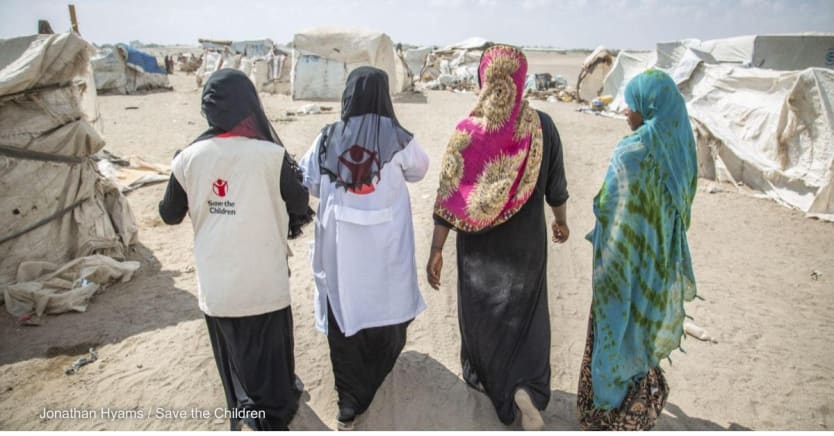
Yemen’s health care system has been hollowed out by years of conflict and is facing a large shortage of health care staff with only 10 health care workers per 10,000 people — well below the international standard of 41 HCWs per 10,000.
Conflict and violence pose a threat not only to HCWs’ physical safety, but also to the wider population by depriving millions of people access to basic health services and treatment, according to the Safeguarding Health in Conflict Coalition’s latest annual report.
Now, the COVID-19 pandemic has further stretched already overworked and underpaid HCWs. “They go to faraway areas and often have to walk more than two hours because of high transportation fees,” said Samah Mohsen, Save the Children’s health and nutrition program officer in Yemen, adding that their wage often isn’t enough to cover basic expenses such as travel to the communities they serve.
Devex spoke to Mohsen to learn more about the need for training more HCWs in the country, the importance of paying them a fair wage, and what it means to serve communities in conflict-affected areas.
This conversation has been edited for length and clarity.
What were some of the biggest challenges facing community health workers in Yemen before the pandemic? And how have these changed given the added pressures of COVID-19?
The biggest challenge is that the ongoing conflict makes life very dangerous and exposes community health workers to numerous security risks.
Another challenge they face is unrealistic workloads due to the low numbers of trained and employed community health workers. They are expected to carry out numerous community-based tasks both for governmental- and nongovernmental organizations, and the payment and incentives are too low and do not match their responsibilities. Community health workers often have to cover their own expenses during daily work, such as transportation to faraway areas.
The ongoing conflict has exposed community health care workers to great risk on a day-to-day basis and they often feel unsafe. One of our community health workers told me that one day during her visit to a faraway area there were sudden armed clashes and she was trapped and very frightened. She even thought that she was going to die. On another occasion, she also had to protect herself from a pack of wild dogs when visiting a remote community.
Female community health workers also tell me that their pay is too low and that it isn't even enough to cover their basic costs such as transportation, which is expensive due to fuel shortages. They often need to take a male relative with them due to the culture and the traditions in their communities and for their personal protection. This has further cost implications as they need to cover the travel- and food expenses for an additional person. So you can be very sure that no community worker is doing her job for the money.
How is Save the Children in Yemen working directly with health care workers to help support them in their work?
Save the Children and GSK joined forces in 2013. Using GSK’s scientific and technical know-how and Save the Children’s on-the-ground presence and expertise, the partnership is finding new ways to bring down the number of children dying from preventable diseases.
Health workers are a key focus for many of the partnership’s programs, which concentrate on training new health workers, building the capacity of countries to deliver better health services and creating demand for health care. To date, through the partnership, over 34,500 health care workers have been trained.
Save the Children and GSK have combined their collective strength to save the lives of children in Yemen since 2014. Amid political instability and violence we have worked to strengthen health systems for mothers and their children.
Save the Children is working closely with the ministry of health to contribute to the reduction of mortality and morbidity rates for children under five years, including neonatal complications from the most common fatal diseases of childhood like diarrhea and pneumonia, malaria, and malnutrition. This is done through community-based interventions and support for six health facilities.
We’re working to increase access to care at the health facility and community level, and to improve the quality of care by providing more training for community health workers. We also try to increase the demand for community health care worker's services among children's caregivers.
Through this program, we have worked with the ministry of health to support the hiring of community health workers where they’re needed and ensure they can be in the community they serve without having to travel too far away and expose themselves to dangers. We also work with the community and traditional leaders to increase the acceptance of community health workers, resulting in strengthening their link to the community.
WHO predicts a health worker shortage of 18 million by 2030. What can be done in a country like Yemen to both educate new health care workers, but also ensure existing ones have access to continuous training and career development opportunities?
Community health workers are an asset to Yemen's health system as they are well trained and have strong relationships with the communities they work with. With the support of the government, they can continue to be a link between the community and the health system by building [people’s] knowledge around how to manage their health and in encouraging them to go to the health facilities for their deliveries and treatment.
Given the value of these health workers, the Ministry of Public Health and Population, as well as the district health office, should count them as a part of the health workforce. Community health workers are a part of the national health system and should be treated as such.
There are currently a lot of discussions about how to “build back better.” What call to action would you give to global health leaders when it comes to what HCWs need to be supported, protected, and equipped to do their jobs?
Community health workers are a critical link to impoverished and marginalized communities who need to access health care in Yemen, as well as in most parts of the world, including other conflict-affected and fragile states. We encourage the global health leaders to work closely with WHO and governments to accelerate investment in health worker’s education, skills, and jobs and make sure they prioritize health care worker’s fair remuneration and their retention — including nurses and midwives, especially in remote and hard-to-reach areas.
There’s also a need to increase the number of community health workers in line with the population density and ensure the recruitment is fully costed and funded. We also need better support for community health workers who are at the forefront of delivering essential services and supporting outbreak response at the community level.
I’d encourage leaders to work with civil society in other countries to develop health workforce action plans that reflect their commitment to universal health coverage, primary health care, and health security, and to also develop targets, financing, and plans to help fill national health worker gaps.








